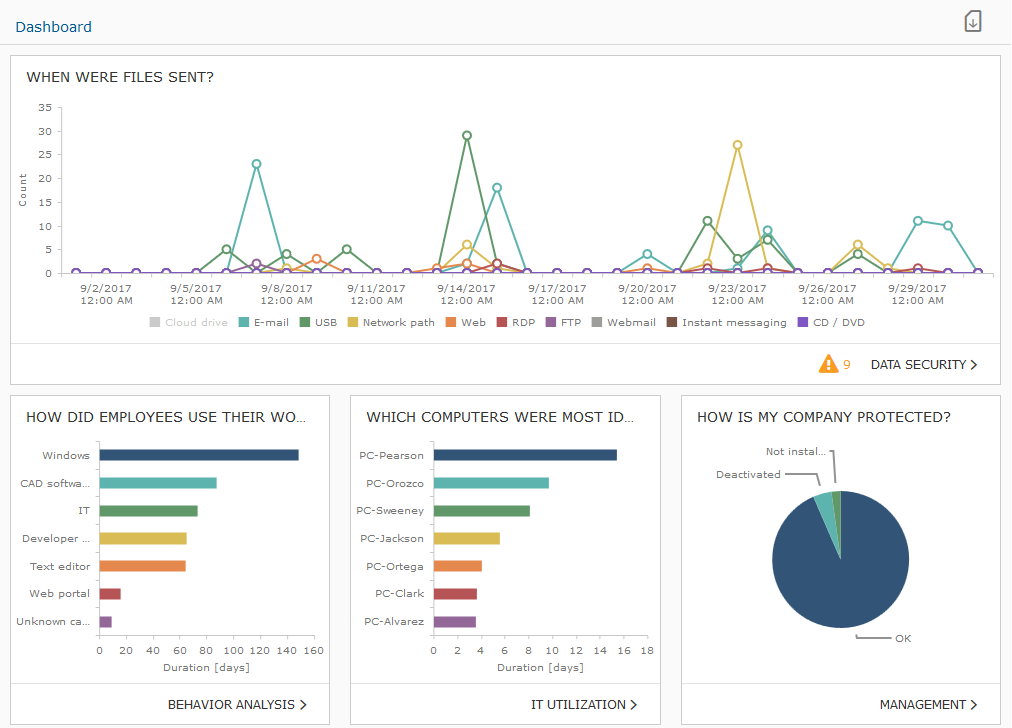Data Loss Prevention
What is Data Loss Prevention (DLP) Solution?
Protection against data loss is a top priority in today’s digital world, especially as remote work becomes more legitimate. Cyberattacks and data breaches are more expensive and dangerous. The concept of data loss prevention (DLP) is a suite of tools and processes that assist companies in identifying and preventing data leakage by controlling information flow within and outside the organization. It performs content evaluation and context-specific analysis of data in motion on a network, in use on a managed endpoint device, or at rest in an on-premises file server or cloud storage.
In short, DLP Solutions are used to
- Prevent data leakage
- Ensure regulatory compliances
- Investigate data breach attempts
How Does DLP Work?
A data loss prevention policy identifies sensitive data at every entry and exit point in an organization's IT power grid. Rule-based content review assists teams in tracking sensitive data throughout the organization, while contextual analysis enables DLP software to tag data, understand appropriate usage, and detect anomalies. Once sensitive data reach an exit point, DLP software identifies unusual activity, halts the transmission, and notifies the user. DLP Solutions are focused on three steps
-
1
Classify data based on its importance
-
2
Secure data with proper rules & policies
-
3
Monitor reports and real-time alerts
Features
The Node IT
Explore our solutions, personal reflections and ideas that inspire action on the services you care about.
Contact us!
FAQ About Data Loss Prevention Solution
What is Data Loss Prevention (DLP)?
Data Loss Prevention (DLP) is a suite of tools and processes that assist companies in identifying and preventing data leakage by controlling information flow within and outside the organization.
Key components of DLP include:
- Data Identification: Recognizing sensitive information to apply appropriate protection measures.
- Policy Enforcement: Implementing rules to prevent unauthorized sharing or transfer of confidential data.
- Monitoring and Reporting: Tracking data access and movement to detect and respond to potential threats.
By implementing DLP strategies, businesses can protect intellectual property, maintain customer trust, and ensure compliance with data protection laws.
How does DLP work to protect sensitive data?
Data Loss Prevention (DLP) safeguards sensitive data by implementing a series of strategic measures:
- Data Classification: Identifying and categorizing data based on its sensitivity and importance.
- Policy Enforcement: Applying rules and protocols to protect classified data from unauthorized access or transmission.
- Monitoring and Alerts: Continuously observing data activities and generating real-time notifications for any policy violations.
By integrating these steps, DLP solutions ensure that sensitive information remains secure, preventing data breaches and maintaining organizational integrity
What are the main features of DLP solutions?
Data Loss Prevention (DLP) solutions offer several key features to safeguard sensitive information:
- Endpoint Data Protection: Ensures that data remains secure from unauthorized access and leakage to external networks. Only authorized personnel can access data, with continuous monitoring of their activities.
- Security Audits & Periodic Reports: Provides various auditing capabilities and regular reports, including data-flow security audits, Office 365 file and email audits, regulatory compliance audits, and workspace security audits.
- Hybrid Data Protection: Monitors and protects data at any stage, whether in motion between nodes or at rest. This includes safeguarding data stored on-premises or in cloud environments.
- Real-Time Alerts: Implements proactive policies that send immediate alerts to administrators upon detecting unauthorized access attempts or potential data misuse.
- Management Training: Offers in-house, certified engineers to implement DLP solutions and support clients during the fine-tuning period post-deployment.
These features collectively enhance an organization’s ability to protect its critical data assets.
What types of data does DLP protect?
Data Loss Prevention (DLP) solutions are designed to protect various types of sensitive data within an organization. They monitor and safeguard data at any stage, whether it’s in motion between nodes or at rest, ensuring that both on-premises and cloud-stored data are secure.
By implementing DLP solutions, organizations can effectively protect their sensitive information, maintain compliance with regulations, and prevent unauthorized data access or leakage.
How can DLP help with regulatory compliance?
Data Loss Prevention (DLP) solutions assist organizations in achieving regulatory compliance through several key mechanisms:
- Security Audits and Periodic Reports: DLP solutions offer a variety of auditing features and periodic reports, including data-flow security audits, Office 365 file and email audits, regulatory compliance audits, and workspace security audits.
- Policy Enforcement: By implementing rules and protocols to protect classified data from unauthorized access or transmission, DLP solutions ensure that data handling aligns with regulatory standards.
- Monitoring and Alerts: Continuous observation of data activities, coupled with real-time notifications for any policy violations, enables organizations to promptly address potential compliance issues.
By integrating these features, DLP solutions help organizations maintain adherence to data protection regulations and avoid potential penalties.
Can DLP solutions protect data in cloud storage?
Yes, Data Loss Prevention (DLP) solutions can protect data in cloud storage. Our DLP solutions monitor and protect data at any stage, whether it’s in motion between nodes or at rest. This includes securing data stored on-premises or in cloud environments.
By implementing DLP strategies, organizations can ensure that sensitive information in cloud storage remains secure, preventing unauthorized access and data breaches.
How can DLP assist in detecting data breach attempts?
Data Loss Prevention (DLP) solutions play a crucial role in detecting data breach attempts through several key mechanisms:
- Monitoring and Analysis: DLP systems continuously monitor data flows and user activities to identify anomalies that may indicate breach attempts.
- Policy Enforcement: By enforcing security policies, DLP solutions can detect and prevent unauthorized data transfers, thereby mitigating potential breaches.
- Real-Time Alerts: When suspicious activities are detected, DLP systems generate real-time alerts, enabling prompt investigation and response to potential threats.
By integrating these features, DLP solutions assist organizations in proactively identifying and mitigating data breach attempts, thereby enhancing overall data security.








